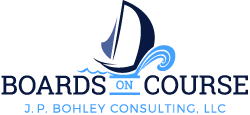Tip #47 How to Get Everyone Engaged in Your Board Meetings
In boards of all sizes, it is important to give special attention to involving all board members in board discussions. This becomes especially important in larger boards. As boards increase in size there is a tendency for individual board members to withdraw, feeling that someone else will step up in the discussion. Also, regardless of board size, with limited time available for discussion, there is the possibility that the discussion will be dominated by a few board members. (If you wish, please check out Tips for Effective Boards #30: How Large Should Your Board Be? by clicking on https://www.BoardsOnCourse.com/blog.)
The following tips for getting everyone engaged in your board discussions are presented for your consideration:
Popcorn Format. Everyone is invited to speak but in no particular order. Consider limiting each participant to one comment until everyone has had a chance to participate. Also, a time limit can be placed on individual comments. Individuals are free to decline to make a comment.
Round Robin Format. Go around the room in order inviting each person to speak. This can be repeated as needed. As with popcorn format, a time limit can be placed on individual comments and individuals are always free to “pass” and decline to make a comment. A discussion could begin with one or two rounds of comments followed by popcorn format participation.
Dyads and Small Groups. Have each board member share his or her ideas with one other board member or in a small group of three or four board members. Then one person from each dyad or small group can report their ideas to the full board. A variant to this process involves each dyad or small group being combined with another dyad or small group before the combined dyads/small groups report out to the full board.
Multi-Voting. After a list of topics or ideas is generated by the full board, decide how many votes each participant will have (generally about 1/3 of the total number of choices) in deciding which ideas to prioritize for further discussion or decision-making. Votes are cast (show of hands, sticky dots placed on flip chart list, colored markers used by participants to place marks on a flip chart by their selected choices) and counted. Additional rounds of voting may be used to reduce the number of ideas selected. A variant of this process allows each participant to cast more than one of their votes for a particular idea as long as they don’t exceed their total allowable votes.
Nominal Group Process. After allowing time for each participant to write down their ideas on the selected discussion topic, participants share one idea at a time in a round robin format until all ideas are shared and recorded on a flip chart, white board, word document projected on a screen, etc. Ideas can be clarified (but not criticized or debated), similar ones combined and duplicates dropped by the group. The remaining ideas are then numbered consecutively. For a list of 15 or fewer items, each participant selects their top five and completes one index card for each selected item using the following format: place the number of the selected item in the upper left corner, a descriptive phrase in the middle of the card, and the idea’s ranking in the lower right corner of the card (ranking of “5” for highest ranked idea and “1” for lowest ranked idea). Completed index cards are collected. Rankings for all ideas selected by participants are recorded on the master list and rankings totaled for each selected item. (Nominal group process can be especially useful for processing controversial ideas.) (Note: This is a ranking of ideas not a rating of individual ideas. In other words, for each participant’s five ideas, the highest would be ranked a “5”, the next highest a “4”, etc., rather than each idea receiving a rating of “1” to “5” with perhaps multiple ideas of an individual receiving the same rating. Also note that “5” is the highest ranking, not “1.” Organizing the rankings with “5” as the best ranking allows for adding up the rankings for each idea with the highest scored idea becoming the group’s top selection, etc.)
As you may remember, in our last few Tips for Effective Boards we have been discussing the 4 P’s for Building Your Board Team: Purpose, People, Plan and Process. In our next two Tips we will continue our discussion of the Fourth P: Manage Your Board Group Process Effectively. In these upcoming Tips, we’ll focus on the following:
- Tips for encouraging creative thinking in the boardroom.
- Tips for managing disagreements and conflicts proactively and constructively.
The 4 P’s incorporate insights from the Policy Governance® model developed by John Carver, from other governance writers and from the group dynamics and team-building literature.
Please take the time to check out the Policy Governance® model. It provides a comprehensive board governance design that supports and enhances effective group process. For more information about the Policy Governance® model click https://www.BoardsOnCourse.com/policy-governance or contact me at jpbohley@gmail.com.
I will be happy to customize a workshop for your board on any or all of the 4 P’s or on the Policy Governance® model which provides an excellent governance design for the 4 P’s. If you would like more information, please respond to this email or contact me via jpbohley@gmail.com.
